*NURSING > STUDY GUIDE > ATI MATERNAL NEWBORN EXAM 2 REVISION GUIDE- LATEST STUDY GUIDE (All)
ATI MATERNAL NEWBORN EXAM 2 REVISION GUIDE- LATEST STUDY GUIDE
Document Content and Description Below
ATI MATERNAL NEWBORN EXAM 2 REVISION GUIDE- LATEST STUDY GUIDE Which woman is most likely to experience strong afterpains? a. A woman who experienced oligohydramnios b. A woman who is a gravida 4, ... para 4-0-0-4 c. A woman who is bottle-feeding her infant d. A woman whose infant weighed 5 pounds, 3 ounces Ans B . A woman who is a gravida, para 4-0-0-4 2. What are the most common causes for subinvolution of the uterus? Retained placental fragments and infection Subinvolution is the failure of the uterus to return to a nonpregnant state. The most common causes of subinvolution are retained placental fragments and infection. Subinvolution may be caused by an infection and result in hemorrhage. Multiple gestations may cause uterine atony, resulting in postpartum hemorrhaging. Uterine tetany and overproduction of oxytocin do not cause subinvolution. 3. A woman gave birth to a 7-pound, 6-ounce infant girl 1 hour ago. The birth was vaginal, and the estimated blood loss (EBL) was approximately 1500 mL. When assessing the woman's vital signs, the nurse would be concerned to see: a. Temperature 37.9° C, heart rate 120, respirations 20, blood pressure (BP) 90/50. b. Temperature 37.4° C, heart rate 88, respirations 36, BP 126/68. c. Temperature 38° C, heart rate 80, respirations 16, BP 110/80. d. Temperature 36.8° C, heart rate 60, respirations 18, BP 140/90. Ans A 4, Which condition, not uncommon in pregnancy, is likely to require careful medical assessment during the puerperium? a. Varicosities of the legs b. Carpal tunnel syndrome c. Periodic numbness and tingling of the fingers d. Headaches Ans D 5. Which nursing action is most appropriate to correct a boggy uterus that is displaced above and to the right of the umbilicus? a. Notify the physician of an impending hemorrhage. b. Assess the blood pressure and pulse. c. Evaluate the lochia. d. Assist the patient in emptying her bladder. Ans D 6 . Rho immune globulin will be ordered postpartum if which situation occurs? a. Mother Rh?2-, baby Rh+ c. Mother Rh+, baby Rh+ b. Mother Rh?2-, baby Rh?2- d. Mother Rh+, baby Rh?2- Ans A Rh?2- mother delivering an Rh+ baby may develop antibodies to fetal cells that entered her bloodstream when the placenta separated. The Rho immune globulin works to destroy the fetal cells in the maternal circulation before sensitization occurs. If mother and baby are both Rh+ or Rh?2- the blood types are alike, so no antibody formation would be anticipated. If the Rh+ blood of the mother comes in contact with the Rh?2- blood of the infant, no antibodies would develop because the antigens are in the mother's blood, not the infant's. 7 On examining a woman who gave birth 5 hours ago, the nurse finds that the woman has completely saturated a perineal pad within 15 minutes. The nurse's first action is to: a. Begin an intravenous (IV) infusion of Ringer's lactate solution. b. Assess the woman's vital signs. c. Call the woman's primary health care provider. d. Massage the woman's fundus. Ans D The nurse should assess the uterus for atony. Uterine tone must be established to prevent excessive blood loss. The nurse may begin an IV infusion to restore circulatory volume, but this would not be the first action. Blood pressure is not a reliable indicator of impending shock from impending hemorrhage; assessing vital signs should not be the nurse's first action. The physician would be notified after the nurse completes the assessment of the woman. 8. A woman arrives at the clinic seeking confirmation that she is pregnant. The following information is obtained: She is 24 years old with a body mass index (BMI) of 17.5. She admits to having used cocaine "several times" during the past year and drinks alcohol occasionally. Her blood pressure (BP) is 108/70 mm Hg, her pulse rate is 72 beats/min, and her respiratory rate is 16 breaths/min. The family history is positive for diabetes mellitus and cancer. Her sister recently gave birth to an infant with a neural tube defect (NTD). Which characteristics place the woman in a high risk category? a. Blood pressure, age, BMI b. Drug/alcohol use, age, family history c. Family history, blood pressure, BMI d. Family history, BMI, drug/alcohol abuse Ans. D 9. Which assessments are included in the fetal BPP? (Select all that apply.) Ans: a,b,c,d a. Fetal movement b. Fetal tone c. Fetal heart rate d. AFI e. Placental grade 10. Biophysical risks include factors that originate with either the mother or the fetus and affect the functioning of either one or both. The nurse who provides prenatal care should have an understanding of these risk factors. Match the specific pregnancy problem with the related risk factor. a. Polyhydramnios b. IUGR (maternal cause) c. Oligohydramnios d. Chromosomal abnormalities e. IUGR (fetoplacental cause) 1. Premature rupture of membranes C (oligohydramnios) 2. Advanced maternal age D( chromosomal abnormalities) 3. Fetal congenital anomalies A( polyhydramnios) 4. Abnormal placenta development E(IUGR)Fetoplacental cause 5. Smoking, alcohol, and illicit drug use B( IUGR) Maternal cause 11. The nurse is planning the care for a laboring client with diabetes mellitus. This client is at greater risk for which clinical finding? a. Oligohydramnios b. Polyhydramnios (amniotic fluid) c. Post term pregnancy d. Chromosomal abnormalities ans B 12. Which statements regarding physiologic jaundice are accurate? (Select all that apply.) a, b, c a. Neonatal jaundice is common; however, kernicterus is rare. b. Appearance of jaundice during the first 24 hours or beyond day 7 indicates a pathologic process. c. Because jaundice may not appear before discharge, parents need instruction on how to assess for jaundice and when to call for medical 13. Which newborn reflex is elicited by stroking the lateral sole of the infant's foot from the heel to the ball of the foot? a .Babinski b. Stepping c. Tonic neck d. Plantar grasp ANS: A The Babinski reflex causes the toes to flare outward and the big toe to dorsiflex. The stepping reflex occurs when infants are held upright, with their heel touching a solid surface, and the infant appears to be walking. The tonic neck reflex (also called the fencing reflex) refers to the posture assumed by newborns when in a supine position. Plantar grasp reflex is similar to the palmar grasp reflex; when the area below the toes is touched, the infant's toes curl over the nurse's finger. 14. While evaluating the reflexes of a newborn, the nurse notes that with a loud noise the newborn symmetrically abducts and extends his arms, his fingers fan out and form a "C" with the thumb and forefinger, and he has a slight tremor. The nurse would document this finding as a positive: a. Tonic neck reflex. b. Glabellar (Myerson) reflex. c. Babinski reflex. d. Moro reflex. Ans D 15. Pain should be regularly assessed in all newborns. If the infant is displaying physiologic or behavioral cues that indicate pain, then measures should be taken to manage the pain. Which interventions are examples of nonpharmacologic pain management techniques? (Select all that apply.) (A, B,C,D). a. Swaddling b. Nonnutritive sucking c. Skin-to-skin contact with the mother d. Sucrose e. Acetaminophen ans a,b,c,d 16. As recently as 2005, the AAP revised safe sleep practices to assist in the prevention of SIDS. The nurse should model these practices in the hospital and incorporate this information into the teaching plan for new parents. Which practices are ideal for role modeling? (Select all that apply.) A, C, D a. Fully supine position for all sleep b. Side-sleeping position as an acceptable alternative c. Tummy time for play d. Infant sleep sacks or buntings e. Soft mattress Ans A,C, D 17. What is the nurse's initial action when caring for an infant with a slightly decreased temperature is to A. Notify the physician immediately B. Wrap the infant in two warmed blankets and place a cap on the head C. Tell the mother that the infant must be kept in the nursery and observed for the next 4 hours D. Change the formula, because this is a sign of formula intolerance Ans B 18. A mother expresses fear about changing her infant's diaper after he is circumcised. What does the woman need to be taught to take care of the infant when she gets home? A) Cleanse the penis with prepackaged diaper wipes every 3 to 4 hours. B) Apply constant, firm pressure by squeezing the penis with the fingers for at least 5 minutes if bleeding occurs. C) Cleanse the penis gently with water and put petroleum jelly around the glans after each diaper change. D) Wash off the yellow exudate that forms on the glans at least once every day to prevent infection. Ans C 19. Which actions are examples of appropriate techniques to wake a sleepy infant for breastfeeding? (Select all that apply.) a. Unwrap the infant. b. Change the diaper. c. Talk to the infant. d. Slap the infant's hands and feet. e. Apply a cold towel to the infant's abdomen. Ans A, B, C 20. A nurse is discussing the signs and symptoms of mastitis with a mother who is breastfeeding. What signs and symptoms should the nurse include in her discussion? (Select all that apply.) a. Breast tenderness b. Warmth in the breast c. An area of redness on the breast often resembling the shape of a pie wedge d. A small white blister on the tip of the nipple e. Fever and flulike symptoms ans. A,B,C,D 21. Which statements concerning the benefits or limitations of breastfeeding are accurate? (Select all that apply.) a. Breast milk changes over time to meet the changing needs as infants grow. b. Breastfeeding increases the risk of childhood obesity. c. Breast milk and breastfeeding may enhance cognitive development. d. Long-term studies have shown that the benefits of breast milk continue after the infant is weaned. e. Benefits to the infant include a reduced incidence of SIDS. Ans a. Breast milk changes over time to meet the changing needs as infants grow. c. Breast milk and breastfeeding may enhance cognitive development. d. Long-term studies have shown that the benefits of breast milk continue after the infant is weaned. e. Benefits to the infant include a reduced incidence of SIDS. 22. Which statement is the best rationale for recommending formula over breastfeeding? a. Mother has a medical condition or is taking drugs that could be passed along to the infant via breast milk. b. Mother lacks confidence in her ability to breastfeed. c. Other family members or care providers also need to feed the baby. d. Mother sees bottle feeding as more convenient. Ans a. Mother has a medical condition or is taking drugs that could be passed along to the infant via breast milk. 23 . A new mother wants to be sure that she is meeting her daughter's needs while feeding the baby commercially prepared infant formula. The nurse should evaluate the mother's knowledge about appropriate infant feeding techniques. Which statement by the client reassures the nurse that correct learning has taken place? a. "Since reaching 2 weeks of age, I add rice cereal to my daughter's formula to ensure adequate nutrition." b. "I warm the bottle in my microwave oven." c. "I burp my daughter during and after the feeding as needed." d. "I refrigerate any leftover formula for the next feeding." Ans c. "I burp my daughter during and after the feeding as needed." 24. The condition, hypospadias, encompasses a wide range of penile abnormalities. Which information should the nurse provide to the anxious parents of an affected newborn? a. Mild cases involve a single surgical procedure. b. Infant should be circumcised. c. Repair is performed as soon as possible after birth. d. No correlation exists between hypospadias and testicular cancer. ANS: A Mild cases of hypospadias are often repaired for cosmetic reasons, and repair involves a single surgical procedure, enabling the male child to urinate in a standing position and to have an adequate sexual organ. These infants are not circumcised; the foreskin will be needed during the surgical repair. Repair is usually performed between 1 and 2 years of age. A correlation between hypospadias and testicular cancer exists; therefore, these children will require long-term follow-up observation. 25 . Most congenital anomalies of the CNS result from defects in the closure of the neural tube during fetal development. Which factor has the greatest impact on this process? a. Maternal diabetes b. Maternal folic acid deficiency c. Socioeconomic status d .Maternal use of anticonvulsant ANS: B All of these environmental influences may affect the development of the CNS. Maternal folic acid deficiency has a direct bearing on the failure of neural tube closure. As a preventative measure, folic acid supplementation (0.4 mg/day) is recommended for all women of childbearing age. 26. . The nurse is assigned a home care visit of a 5-day-old infant for the treatment of jaundice. A thorough assessment is completed, and a health history is obtained. Which sign or symptom indicates that the infant may be displaying the initial phase of encephalopathy? a. High-pitched cry b. Severe muscle spasms (opisthotonos) c. Fever and seizures d .Hypotonia, lethargy, and poor suck ANS: D The early and most subtle symptoms of bilirubin encephalopathy include hypotonia, lethargy, poor suck, and a depressed or absent Moro reflex. Should the infant display symptoms such as a high-pitched cry, severe muscle spasms, hyperreflexia, or an arching of the back, the nurse should be aware that the baby has progressed beyond the more subtle signs of the first phase of encephalopathy. Medical attention is immediately necessary. Symptoms may progress from the subtle indications of the first phase to fever and seizures in as few as 24 hours. Only approximately one half of these infants survive, and those that do will have permanent sequelae, including auditory deficiencies, intellectual deficits, and movement abnormalities. 27. A primigravida is being monitored in her prenatal clinic for preeclampsia. What finding should concern her nurse? a Pitting pedal edema at the end of the day b A dipstick value of 3+ for protein in her urine c Weight gain of 0.5 kg during the past 2 weeks d Blood pressure (BP) increase to 138/86 mm Hg Ans A dipstick value of 3+ for protein in her urine CONTINUED...............DOWNLOAD FOR BEST REVISION GUIDE AND SCORES [Show More]
Last updated: 1 year ago
Preview 1 out of 24 pages
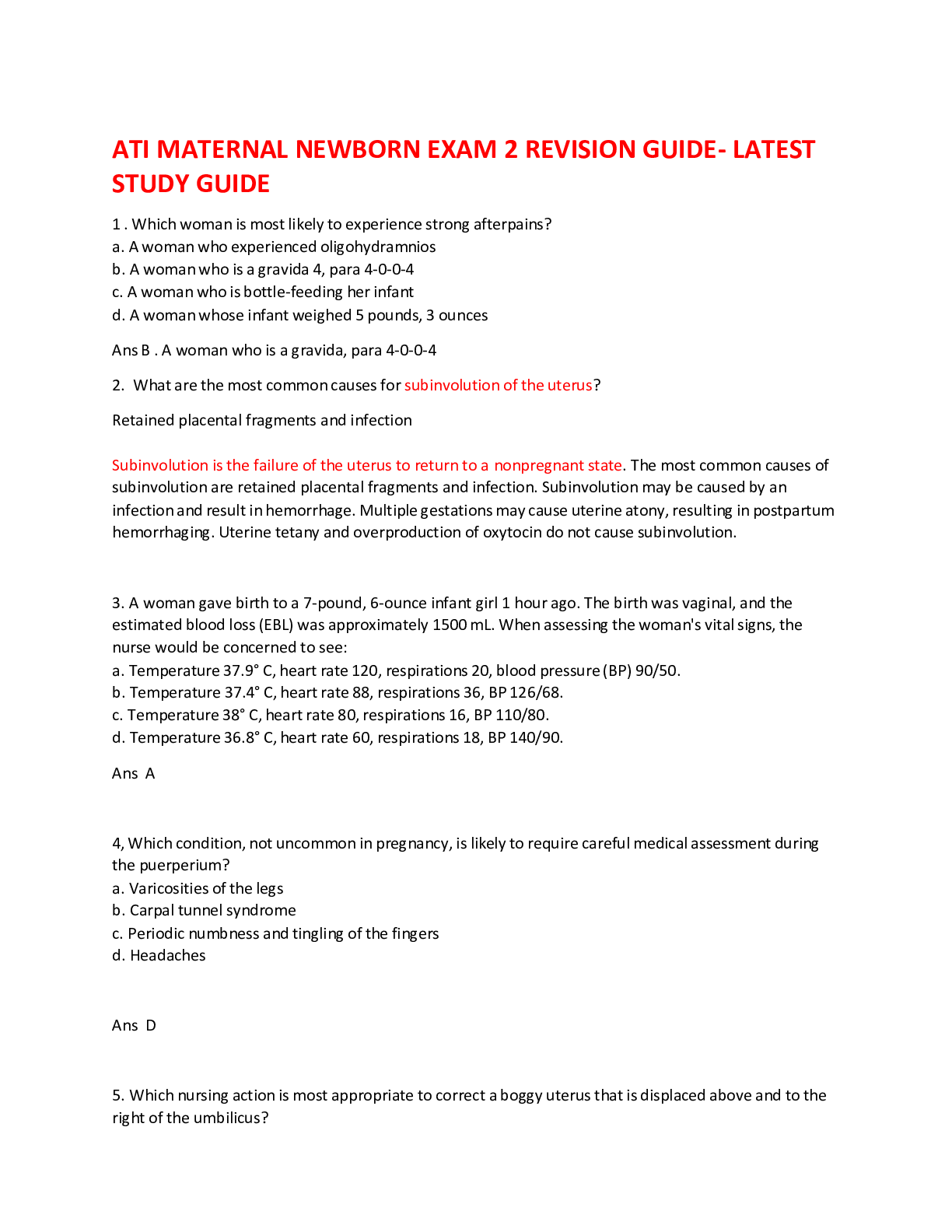
Reviews( 0 )
Document information
Connected school, study & course
About the document
Uploaded On
May 04, 2022
Number of pages
24
Written in
Additional information
This document has been written for:
Uploaded
May 04, 2022
Downloads
0
Views
46

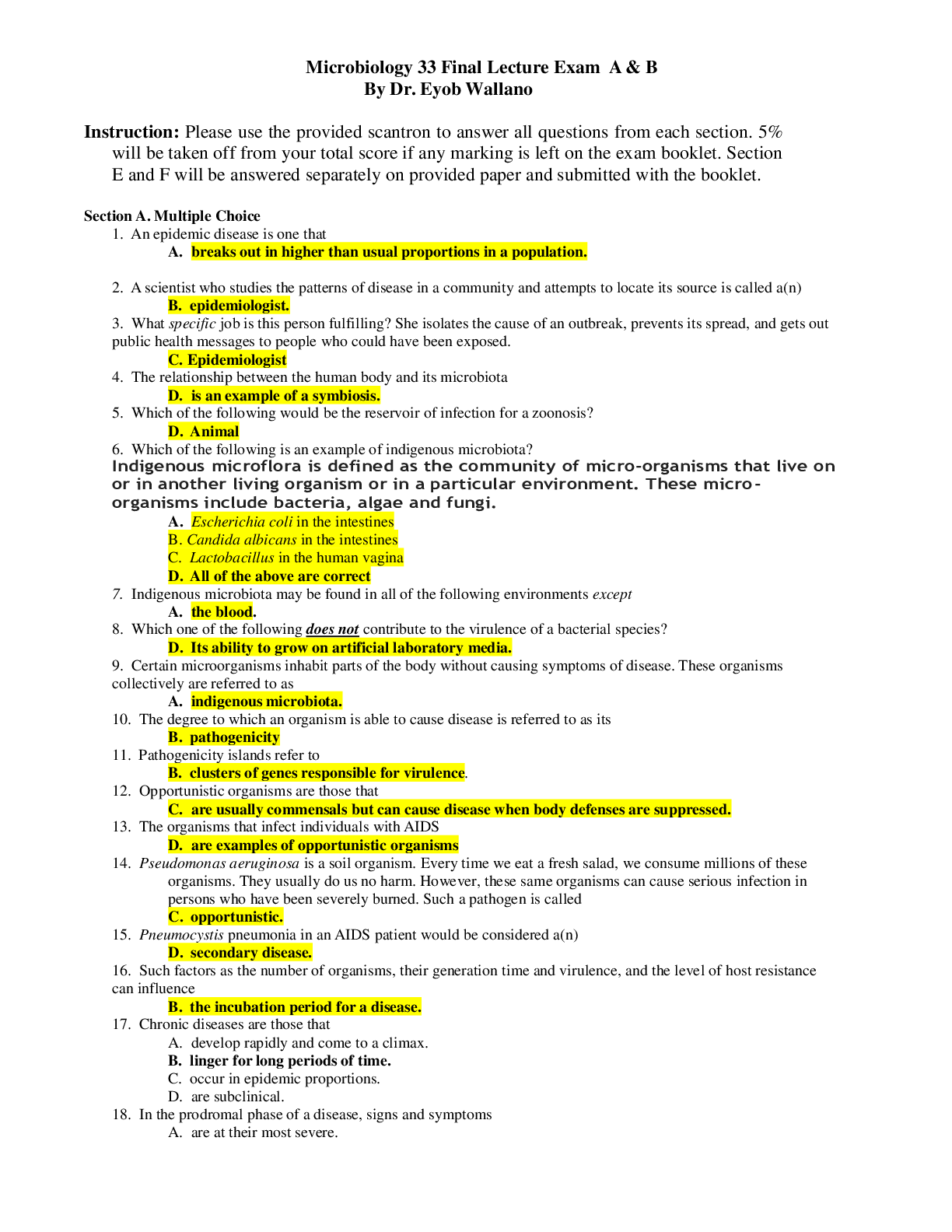
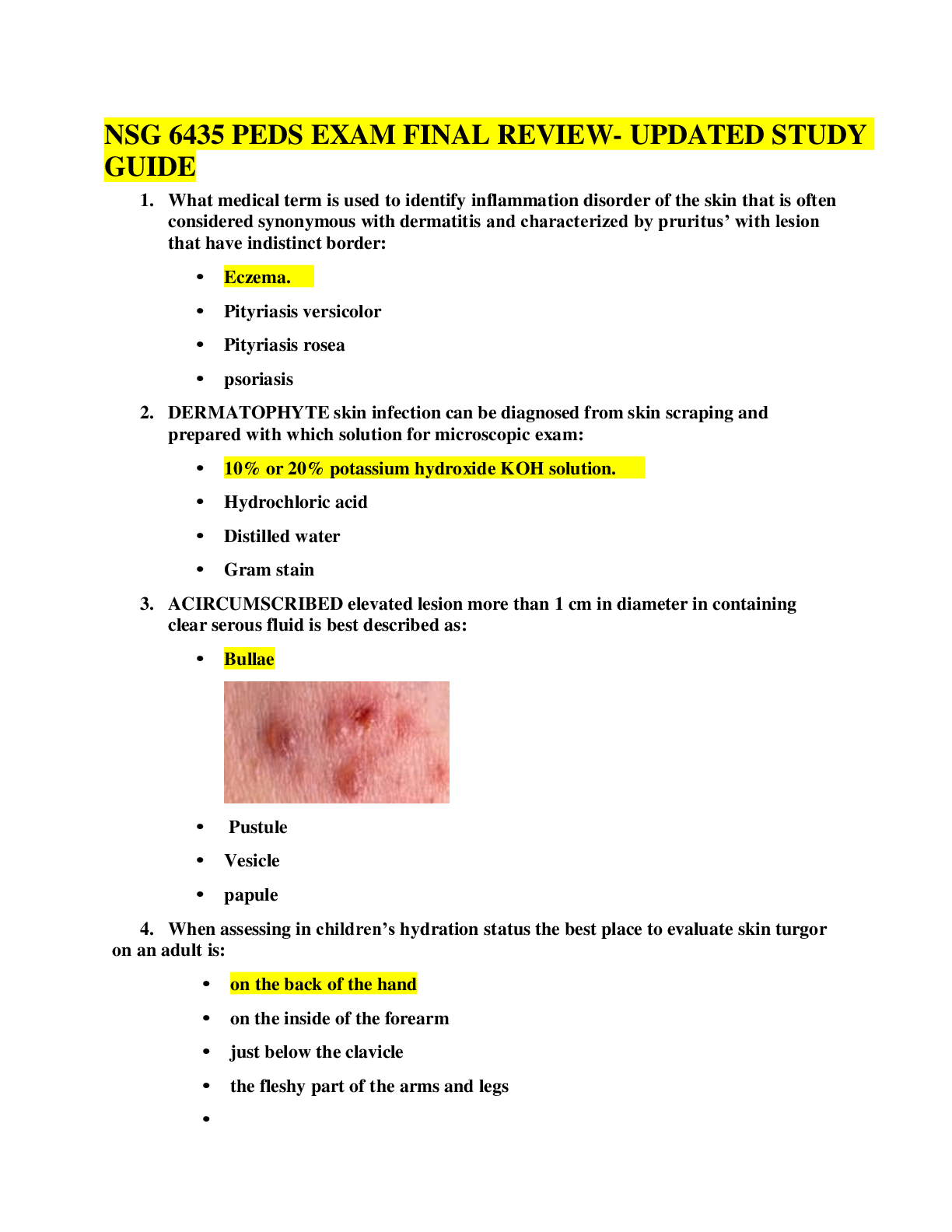




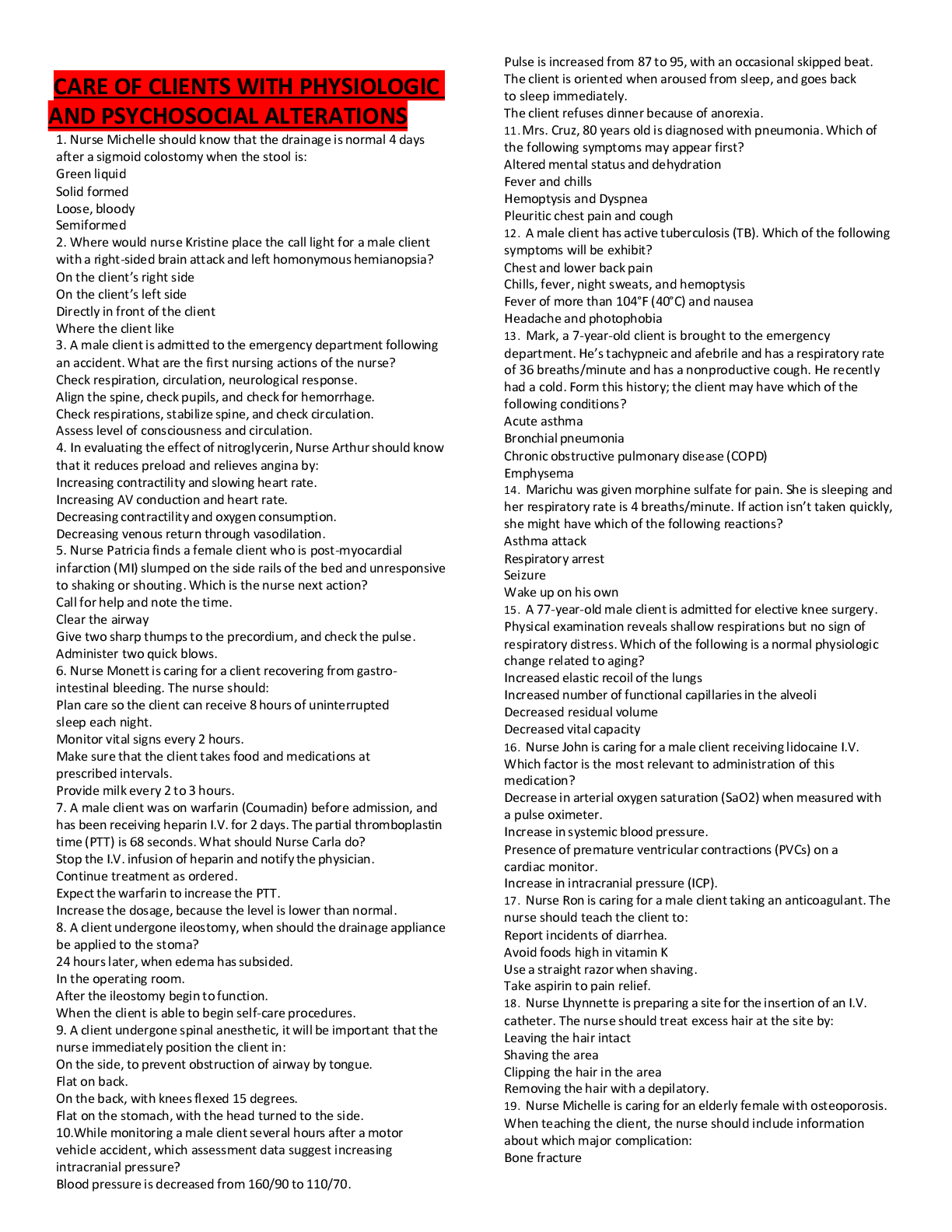



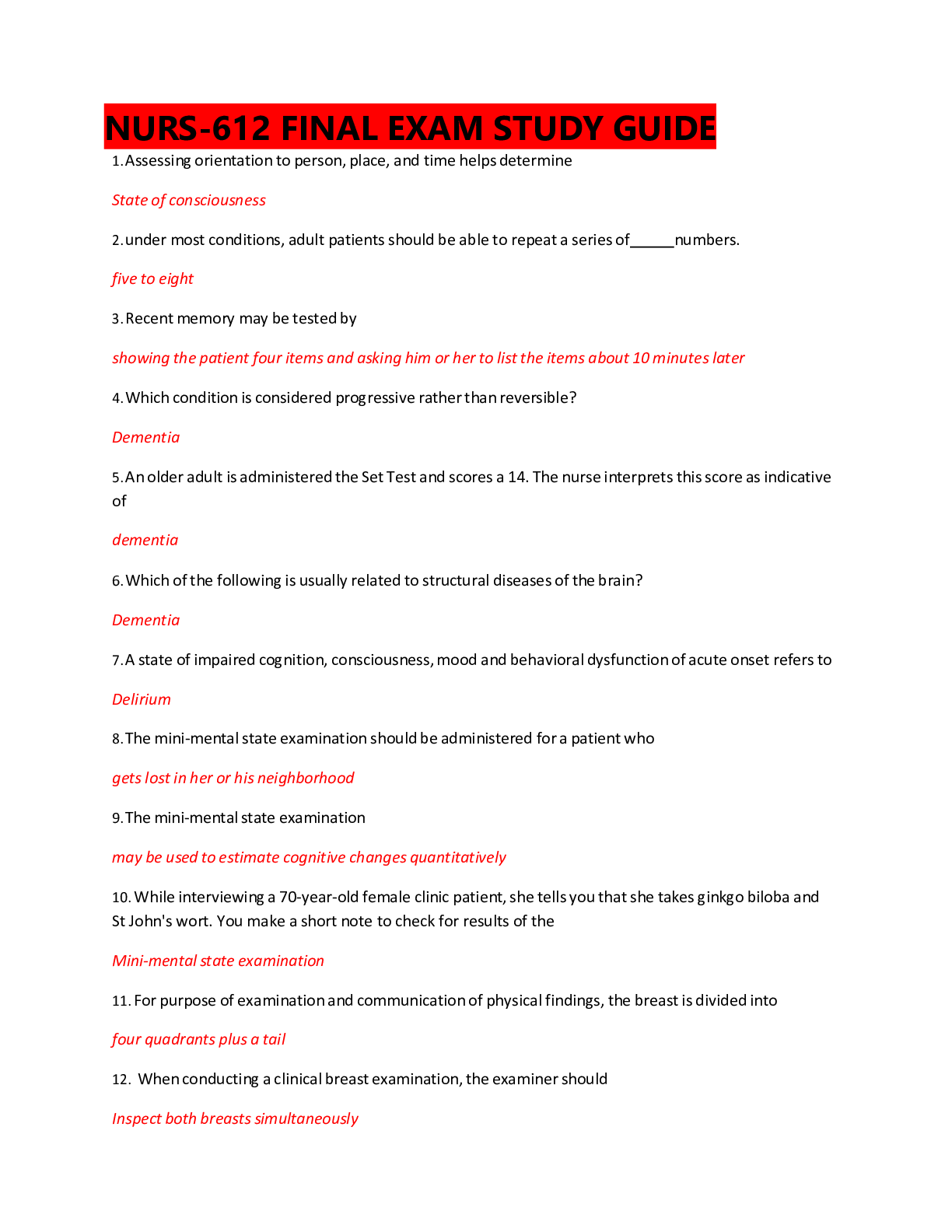
 BMAL 590- QUANTITATIVE RESEARCH TECHNIQUES AND STATISTICS TEST WITH SUMMARIZED STUDY GUIDE.png)
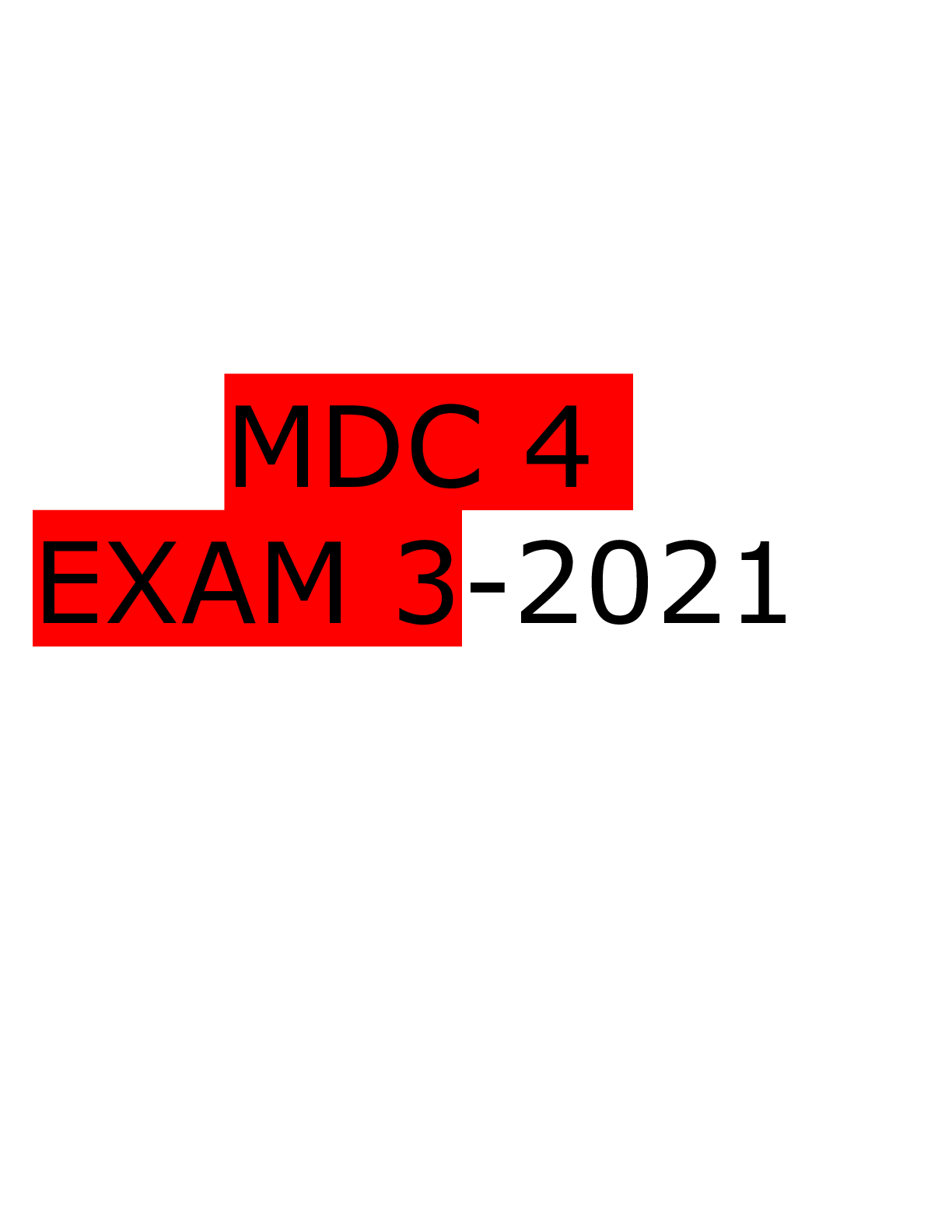
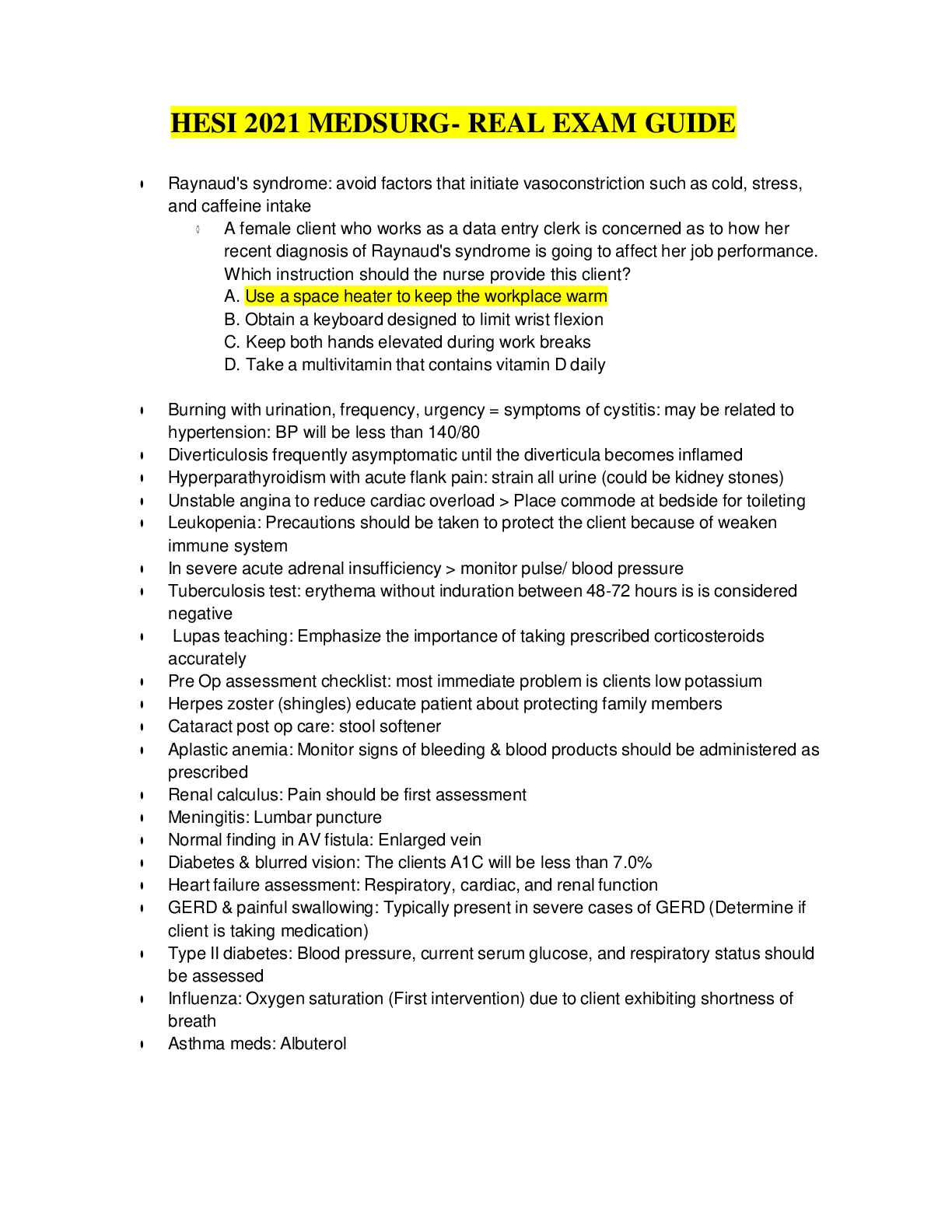


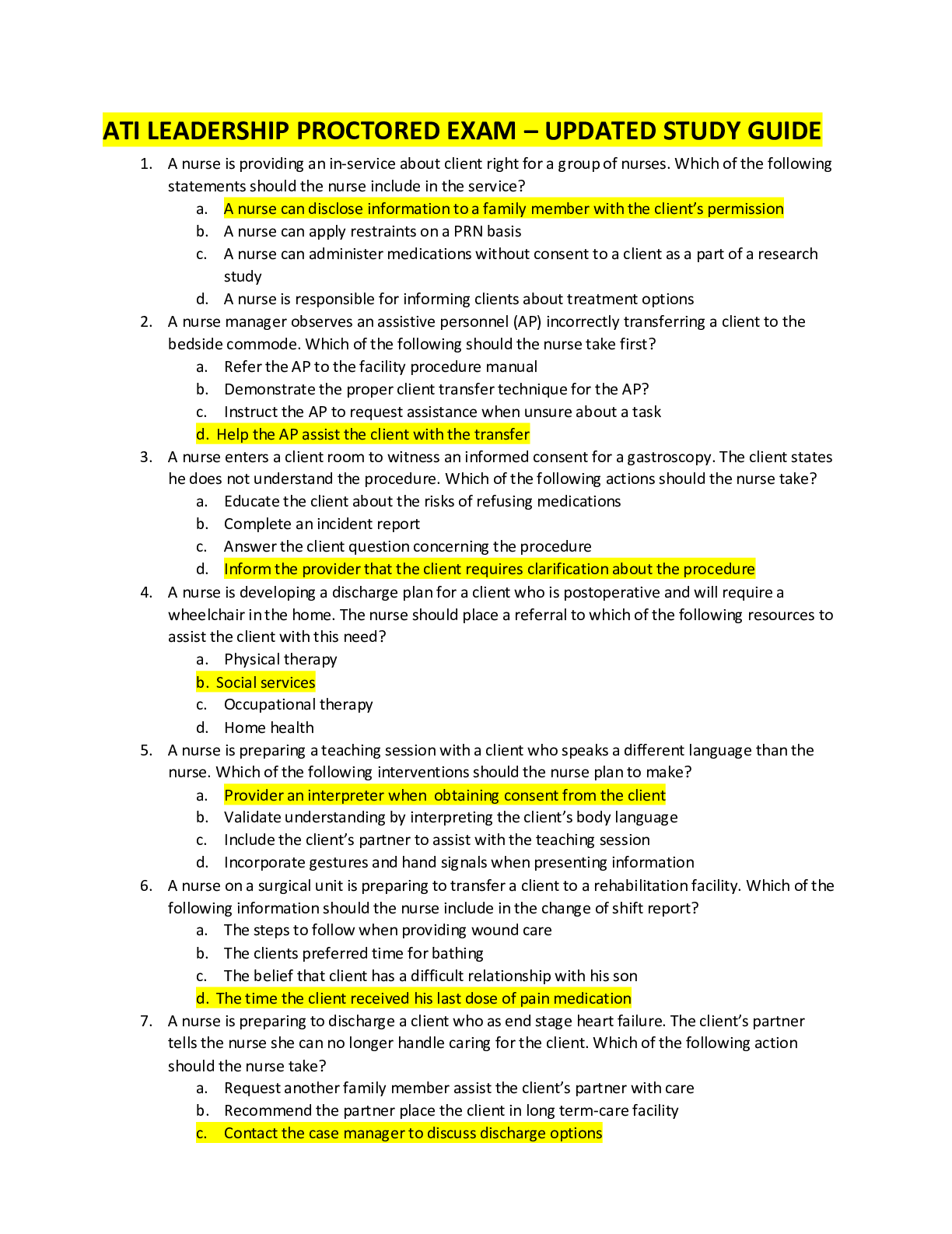

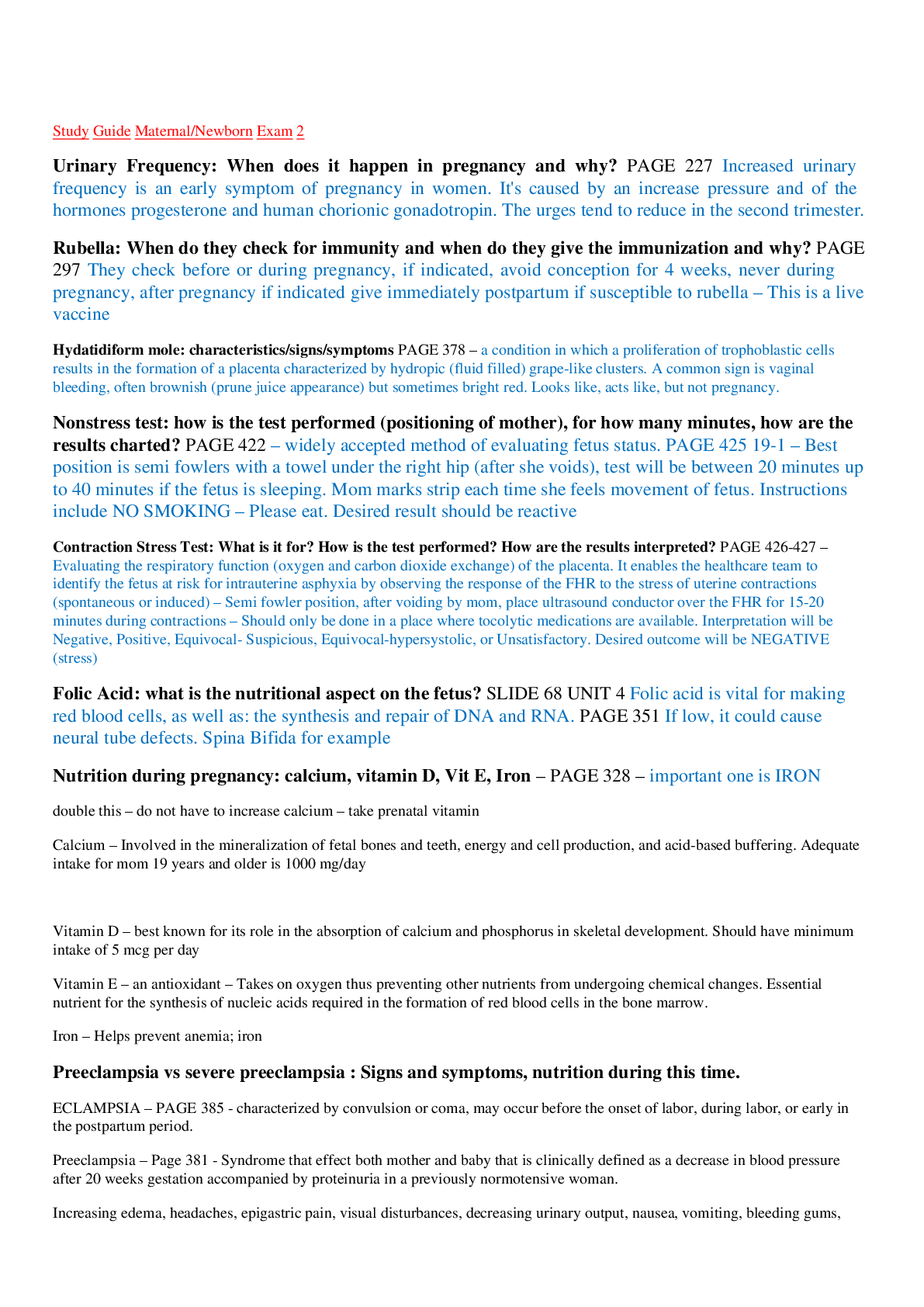
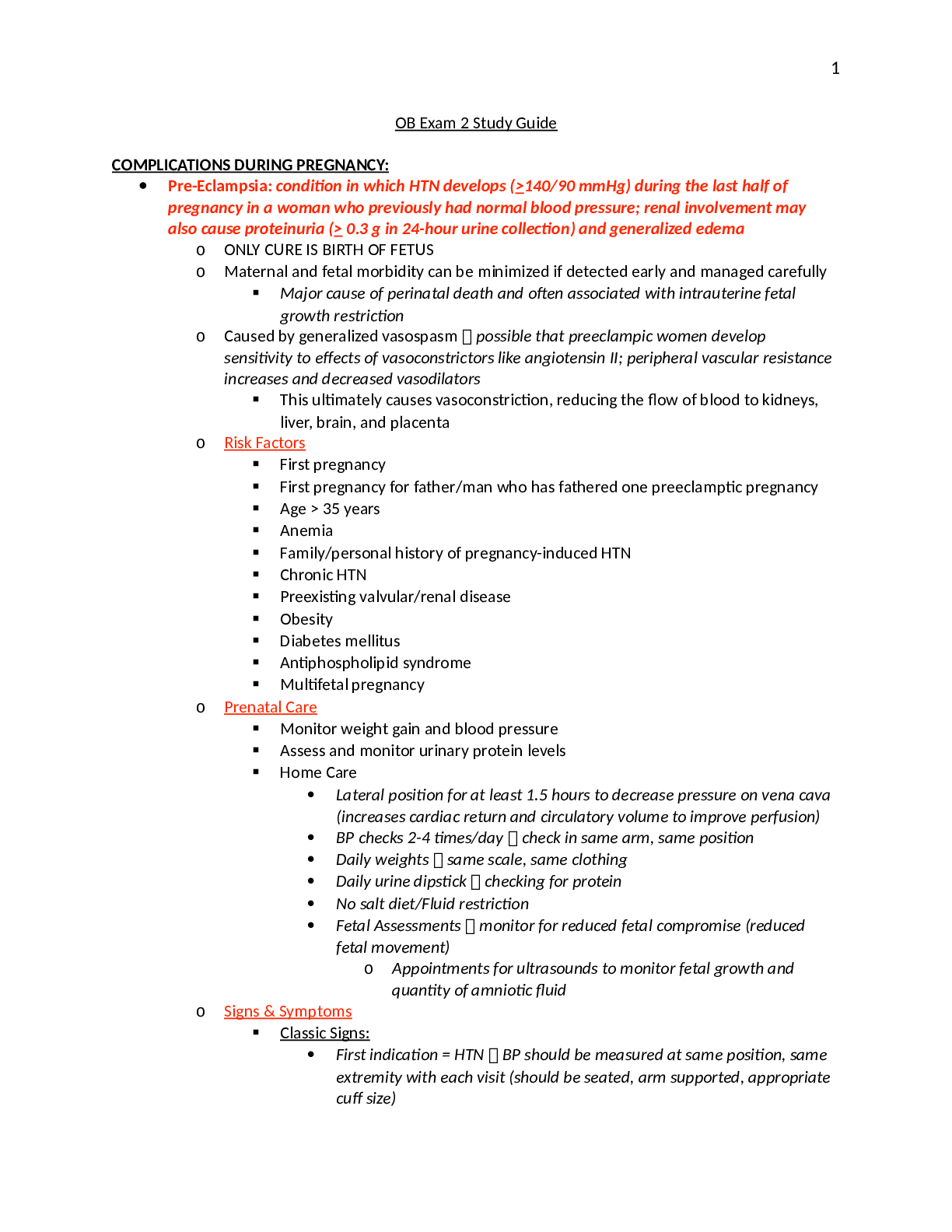
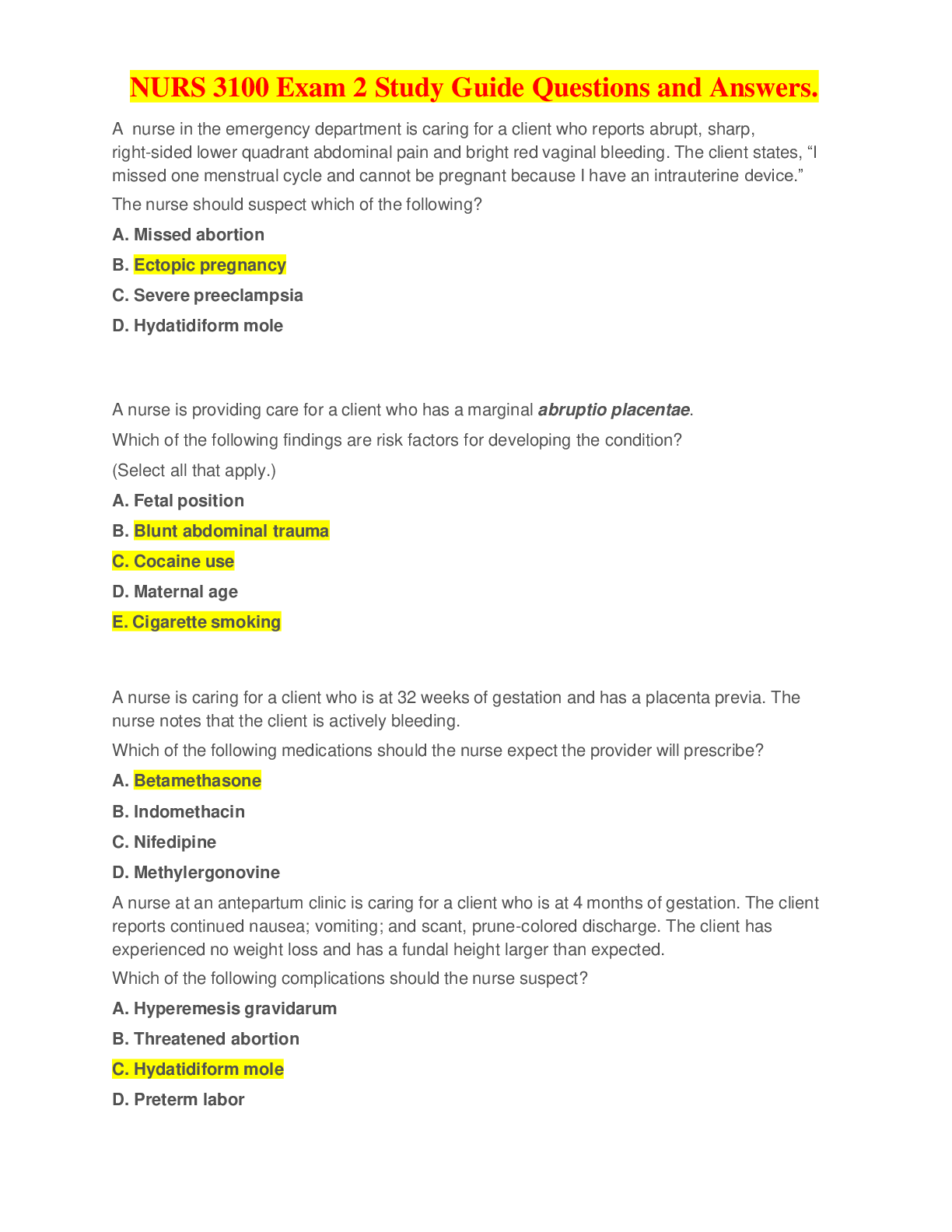
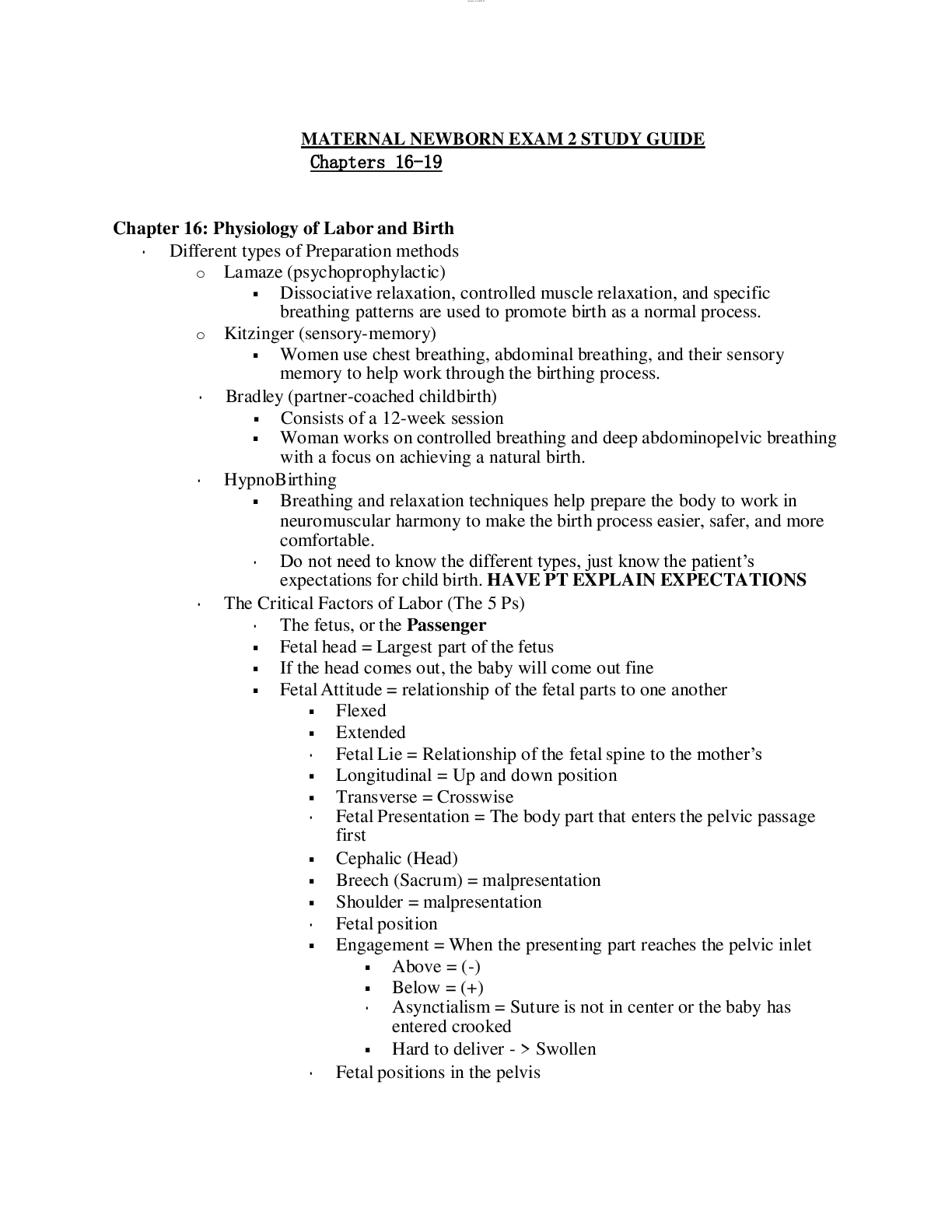








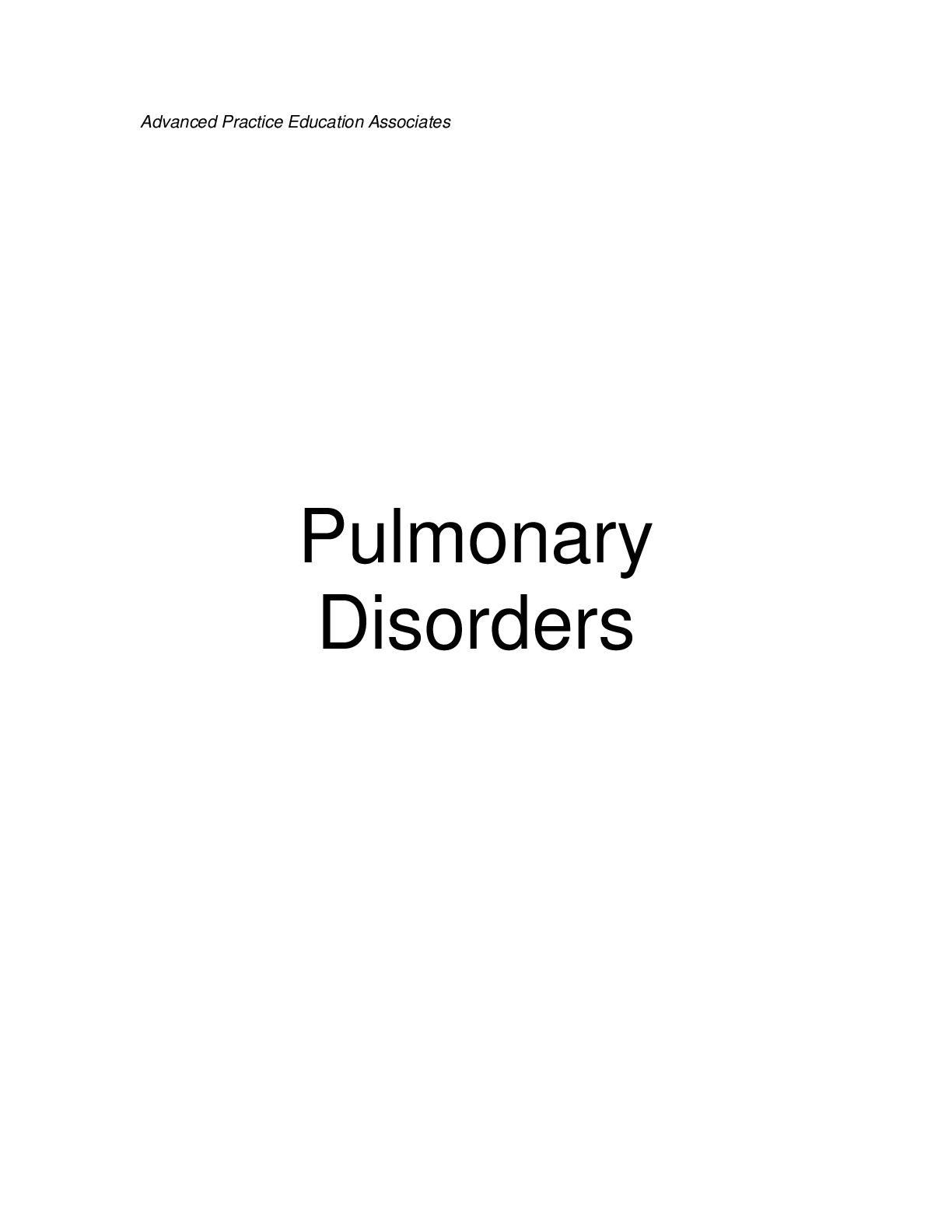
.png)





